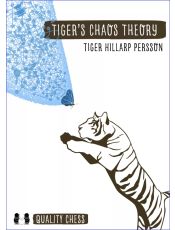NIC Podcast #37 - GM Tiger Hillarp Persson
In this week’s New In Chess Podcast episode, Dirk Jan ten Geuzendam talks to Swedish grandmaster Tiger Hillarp Persson. Tiger is a three-time Swedish champion and has been described as ‘one of our game's most creative and non-standard players’.
An abundance of his creativity can be found in his new book Tiger’s Chaos Theory, which was the reason to invite Tiger to the Podcast.
These days Tiger Hillarp Persson divides his time between playing competitive chess, coaching, playing Go, writing books and much more. Having written two books on The Modern Defence, he was challenged by Jacob Aagaard of Quality Chess to write a book about creativity.
Tiger picked up the gauntlet, wrestled with the subject for years and wrote a beautiful book. Creativity makes many appearances in the book, but it’s become so much more as the author shows and investigates games and themes that formed his chess philosophy.
It's a very personal book, a tour of Tiger’s world of fascinating chess with an expert guide. Hecatomb sacrifices and Houdini Breakouts may sound puzzling when you open the book, but will have become dear friends once you’ve read it. And perhaps one day soon, you too will start ‘talking to your pieces’.
Listening to this New In Chess Podcast episode will make you understand why Dirk Jan calls Tiger’s Chaos Theory a perfect desert island book.
And if you didn’t know how Tiger Hillarp Persson got his remarkable first name, you’ll get an answer, too.
If you want to read sample pages of Tiger’s Chaos Theory, go to the product page on our website, where you can order the book.
The New In Chess podcast is published every Friday and can be listened to on Spotify, Apple Podcasts and the New In Chess website.
Timestamps
00:00 – Intro
01:33 – How did Tiger feel when finally holding the book he’d spent so much time working on?
03:04 - Tiger clarifies at what age he started playing chess and recalls playing with his father
05:02 – Why did his parents pick the name Tiger?
09:11 – How did Tiger’s “Tiger’s Chaos Theory” come about?
11:18 – Tiger’s database of his own games that impacted the way he played in the future
14:56 – Why Tiger’s book does not propose a “grand theory” of chess
17:21 – The chapter on queen sacrifices
20:30 - Why a good chess player should strive for objectivity
23:10 – Tiger’s use of metaphors and stories in his writing
26:31 – Why Tiger talks to his pieces, and his students should too
29:43 – Tiger’s scepticism towards material
30:41 – Tiger clarifies certain quotes from the book
31:12 – AD BREAK
33:37 – How does this book relate to Tiger’s other passions, like go and music?
38:40 – Tiger’s humble beginnings and relative disregard for money
42:01 – Tiger’s favourite classical music
46:21 – AD BREAK
47:21 – Why Tiger considers chess more of a science than an art, the role of the engine
58:01 – Outro
